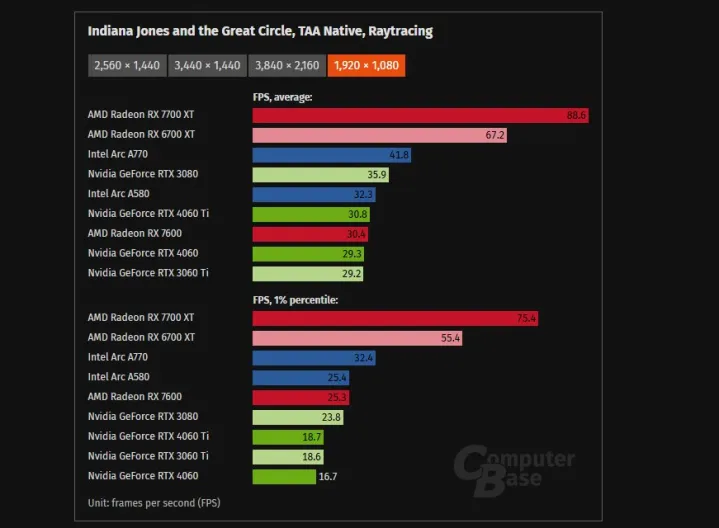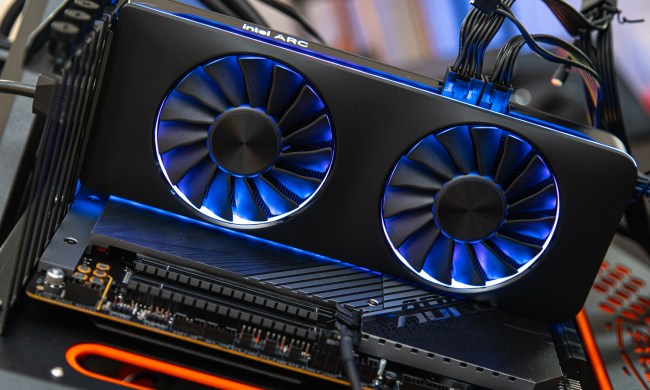Nvidia was wrong, and Indiana Jones and the Great Circle is proof of that. Despite being a game that’s sponsored by Nvidia due to its use of full ray tracing — which is said to arrive on December 9 — multiple of Nvidia’s best graphics cards struggle to maintain a playable frame rate in the game, and that largely comes down to VRAM.
Computer Base tested a swath of GPUs in the game across resolutions with the highest graphics preset, and one consistent trend emerged. Any GPUs packing less than 12GB of VRAM couldn’t even maintain 30 frames per second (fps) in the game at its highest graphics settings. That led to some wild comparisons as you can see in the chart below. The Intel Arc A770, for example, which is a budget-focused 1080p graphics card, beats the RTX 3080, which was the 4K champion when it launched. Why? The A770 has 16GB of VRAM, while the RTX 3080 has 10GB.

With Nvidia’s latest GPUs, the company faced pushback due to many of the lower-end cards only featuring 8GB of VRAM. Nvidia defended this position, particularly on cards like the RTX 4060 Ti, claiming that 8GB was enough to satisfy the demands of modern games if paired with a faster memory interface. The performance in Indiana Jones and the Great Circle suggests something different.
This is particularly problematic at 1080p, where the options for high VRAM capacity are few and far between. As you can see in the benchmarks below, even the last-gen RX 6700 XT can manage 60 fps at 1080p, but Nvidia’s RTX 4060, RTX 4060 Ti, RTX 3080, and RTX 3060 Ti can barely muster 30 fps.

That shouldn’t be happening. Indiana Jones and the Great Circle requires dedicated ray tracing hardware. Even without the full ray tracing mode, the game still uses ray tracing throughout with no option to turn it off. It’s no secret that Nvidia GPUs handle ray tracing better than AMD’s, and that’s especially true when looking at AMD’s RX 6000 GPUs, which struggle massively with ray tracing. Still, the higher VRAM capacity on a card like the RX 6700 XT allows it to achieve higher performance in this game.
Nvidia pointed out to me that it believes Indiana Jones and the Great Circle still looks great at lower graphics settings — something I’ve picked up on in my own time with the game. The key issue here is VRAM capacity, however. Based on this testing, someone with a $700 RTX 3080 will have to compromise on visuals even at 1080p, while someone who spent $400 on an RX 6700 XT won’t. Indiana Jones and the Great Circle supports DLSS 3, including Super Resolution and Frame Generation, to boost performance. Those tools don’t help much if you’re running into a VRAM wall at your chosen resolution, however.
Digital Foundry has taken a look at the game on PC, as well, noting that it’s possible to get playable performance by lowering a combination of texture quality, shadow quality, and hair quality depending on your VRAM budget. These settings changes don’t have a massive impact on visual quality based on the video, though they can lower the level of detail in distant textures, as well as shadows.
This isn’t the only example of games struggling with 8GB graphics cards, but it might be the most extreme. Over the past two years, we’ve seen titles like Resident Evil 4, The Last of Us Part One, and Halo Infinite struggle on 8GB graphics cards. With Indiana Jones and the Great Circle, however, the situation is even more extreme. Let’s hope Nvidia bumps VRAM capacity up once RTX 50-series GPUs are here.





